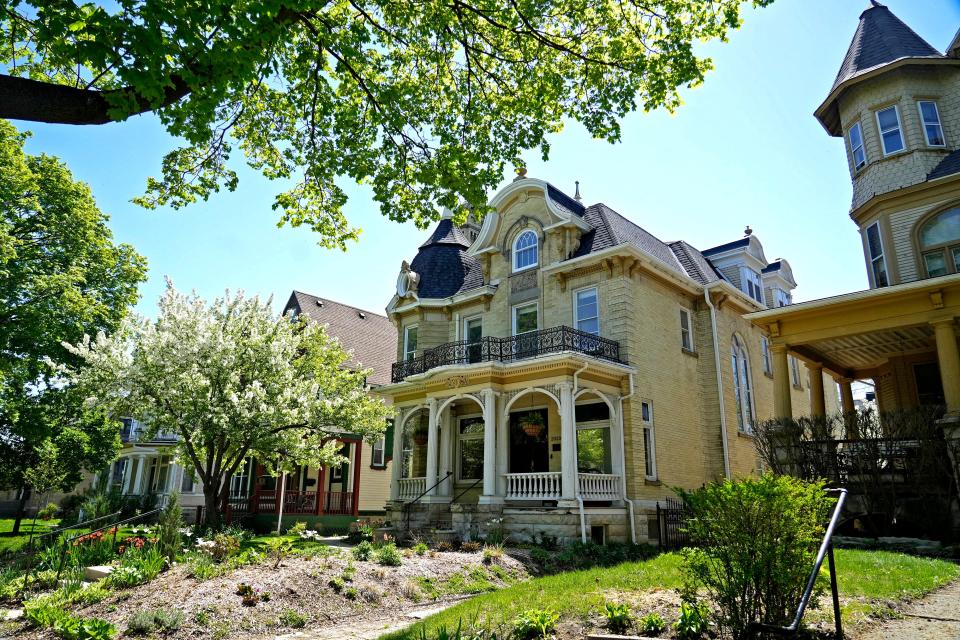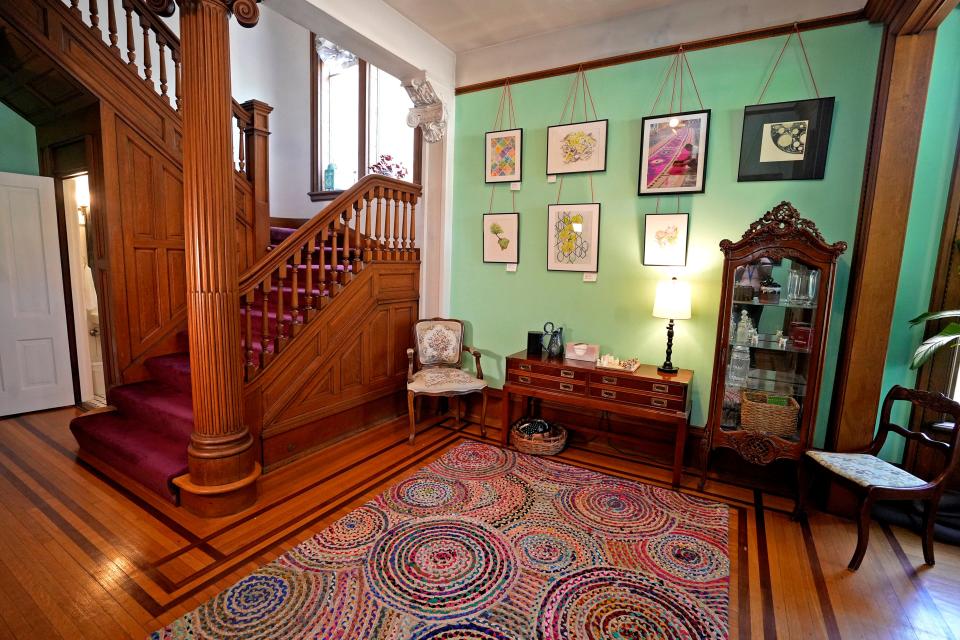Your guide to Milwaukee's Concordia neighborhood
If you ever find yourself daydreaming about buying an old mansion, fixing it up and making it your own, you'll want to take a walk around Milwaukee's Concordia neighborhood.
Full of historic houses that were once owned by members of the city's elite before they fell into disrepair, the neighborhood is a love letter to Victorian architecture on the near west side and a testament to the art of home preservation. Milwaukee Mayor Cavalier Johnson moved there in 2022, telling Milwaukee Magazine he fell for the neighborhood's history and its shorter commute to City Hall.
The Concordia neighborhood is one of more than 75 distinct neighborhoods in Milwaukee, and in addition to its old houses, it's also home to some new developments. Here's what you should know about it.
More: How many neighborhoods are there in Milwaukee? Here's why there's no 'right' answer.
Where is Milwaukee's Concordia neighborhood?
The Concordia neighborhood is on Milwaukee's near west side — slightly farther west than the aptly named Avenues West neighborhood. It's bordered by Highland Boulevard to the north, Wisconsin Avenue to the south, North 27th Street to the east and North 35th Street to the west.
Wealthy Germans, Lutheran pastors-to-be were early residents
As Milwaukee's wealthy families moved west on Wisconsin Avenue at the end of the 1800s, they began to spread north to Highland Boulevard, creating what Milwaukee historian John Gurda called "a zone of affluence" on the near west side. Members of the iconic Pabst family called the neighborhood home, as did Daniel Hoan, mayor of Milwaukee from 1916 to 1940, and the Usingers of sausage-making fame.

More: At 19, she bought the Mayor Hoan house. It's on the Concordia Historic Home Tour.
At one point, the area was so populated by wealthy German families that it was nicknamed "Sauerkraut Boulevard," according to Gurda's short history video on the neighborhood.
Another early presence was Concordia College, then a seminary school training Missouri Synod Lutheran pastors, which established downtown in 1881 and moved to the neighborhood in 1883, giving it its name.
More: 5 things to know about the Avenues West neighborhood
More: What to know about Milwaukee's Brewers Hill neighborhood
Concordia's lavish mansion era was intense but short-lived, according to Gurda, as wealthy families purchased cars and sprawled further out of the city. Around World War I, mansions began to be divided up for rooming houses, while others were torn down to make room for apartment complexes as the density of the area grew. The trend intensified and continued well after World War II.
Concordia College was expanding at the same time, transitioning to a four-year, coed school that offered instruction in a handful of other subjects besides ministry. School officials began to buy up property around the campus, Gurda said, tearing down about 50 houses and managing others in a way that left neighbors disgruntled.
In 1983, the college moved to Mequon, where it remains today as Concordia University Wisconsin.
Following its departure, the Forest County Potawatomi purchased the property in 1990, and part of the campus was leased to the Indian Community School. That school moved to its new Franklin campus in 2010, but the tribe still owns the property today, now called the Wgema Campus.
After falling into disrepair, Concordia's historic mansions have been lovingly restored
As the college left the neighborhood, preservationists were eyeing its old homes for rehabilitation.
A nonprofit bought the homes, repaired them and sold them to owner-occupants, according to Gurda. After that, the neighborhood began to grow in a new way. People who loved older homes, and had the time and money to rehab the properties, were able to restore them to their former glory. Some of that work is still going on today.

A number of the houses have also been converted to bed and breakfasts, so much so that the city proclaimed the Concordia neighborhood as Milwaukee's Bed and Breakfast District in 2000.
The neighborhood was designated a National Historic District in 1985, a State Historic District in 1989, and a City Historic District in 1988, according to Historic Concordia Neighbors, Inc.
More: 5 things to know about Milwaukee’s Sherman Park neighborhood
More: What to know about Piggsville, one of Milwaukee's smallest, most secluded neighborhoods
What is there to see, do and eat in the Concordia neighborhood?
Perhaps the neighborhood's most famous event is its annual home tour, where people can get a glimpse into several historic homes. In 2024, it'll be held June 15, said Barry Weber, president of Historic Concordia Neighbors, Inc. It will highlight "more of the unique and wonderful aspects of our neighborhood," Weber said, including residents' gardens and local organizations.
But there are more than just homes to explore here. The Tripoli Shrine Center on West Wisconsin Avenue, completed in 1928, is an architectural replica of India's Taj Mahal. Neighborhood House, a community-based educational center that offers programming for children, teens and adults, has its home base in Concordia. The Goodway Grille, as well as Jizzles Sandwich Shop and Daddy's Soul Food & Grille — though technically just across North 27th Street within the borders of Avenues West — are favorite local eateries, Weber said.
More: Your guide to Milwaukee's Story Hill neighborhood
More: Five things to know about Milwaukee's Rufus King neighborhood
The neighborhood is also undergoing some new developments.

That includes an all-ages music venue planned for the site of the old Palms Music Club — which once hosted acts such as U2, Joan Jett, The Police, B-52s and Tom Petty, as well as a 1981 concert by the punk band Plasmatics, after which lead singer Wendy O. Williams was arrested for making lewd gestures. The venue, called The New State, would also host a nonprofit arts group to help young people learn about the music business and a new restaurant, Dulaney's.
And a long-vacant historic building on the corner of West Wells and North 27th streets is getting a $20 million facelift. The development, Concordia 27, will include a commercial kitchen, co-working space, affordable apartments and other new uses.
New to the neighborhood? Here's how to access Milwaukee services
The Concordia neighborhood is in the 4th aldermanic district. Contact your alderperson and find news about the district at city.milwaukee.gov/CommonCouncil/CouncilMembers/District4.
The Concordia neighborhood falls within Police District 3. Public meetings take place once a month on Thursdays. Visit city.milwaukee.gov/police/districts/District-3 for more information.
Find your garbage and recycling schedule at city.milwaukee.gov/sanitation/GarbageRecyclingSchedules.
Learn how to register to vote and find your polling place at city.milwaukee.gov/election/Voter-Info.
Need to borrow tools for a home improvement project? Check out the city’s Tool Loan Center, 2500 W. Capitol Drive. More details at bit.ly/MKE_ToolLoan.
Want to get emailed updates about police activity, new development and more in your neighborhood? Sign up for the city’s e-notify system at city.milwaukee.gov/News-Events/enotify.
Tell us about your Milwaukee neighborhood
What makes your Milwaukee neighborhood special to you? Do you have any photos in the neighborhood you'd like to share? Tell us at bit.ly/MKE_Neighborhoods.
Information in this guide was supplied by: John Gurda's brief history of the Concordia neighborhood, Historic Concordia Neighborhood, Inc. and neighborhoodsinmilwaukee.org.
This article originally appeared on Milwaukee Journal Sentinel: Milwaukee's Concordia neighborhood: A guide
